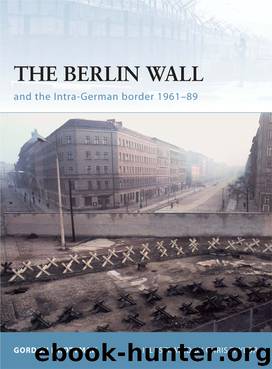The Berlin Wall and the Intra-German Border 1961-89 by Gordon L. Rottman

Author:Gordon L. Rottman
Language: eng
Format: epub
Tags: The Berlin Wall: and the Intra-German Border 1961–89
ISBN: 9781782005087
Publisher: Osprey Publishing
Published: 2017-04-29T04:00:00+00:00
Grenzwall 75 elements being emplaced. Usually the L-shaped base was on the inside, rather than on the outside as here. A temporary steel fence has been emplaced as much to keep harassing West Berliners away as to keep in workers.
With the seams and hoisting holes tarred, the 30cm-diameter, slotted, sewer pipe sections are hoisted into place atop Grenzwall 75 elements. The smooth pipe prevented escapees from getting any grip.
A Grenzer looks on from behind a temporary fence as the new Grenzwall 75 is erected in the background. In the foreground is the memorial to Olga Segler, an East German killed when attempting to escape over the Wall. (IWM CT 1495)
In some areas, 6m or wider harrowed control strips paralleled the outer wall, while in others most of the area enclosed by the outer wall and inner fence (comprising bare sandy soil) served as a control strip. To prevent vehicles attempting to crash through the Wall, V- and square-shaped ditches, steel hedgehogs and fields of spikes (‘Stalin’s grass’) were emplaced.
Floodlights, set atop steel and concrete poles in kilometre-long lines (Lichttrosse), illuminated the cleared strip and the interior side of the Wall. PSG-80 sentinel signal devices (Postensignalgerät) – trip flares – also formed part of the system. The PSG-80 comprised a flare cartridge on a small wire tripod or stake, with 30–50cm-high tripwires running in both directions parallel to the Wall. When tripped, the magnesium flare burned for about a minute illuminating a 100m radius; some PSG-80s made a flash-bang report.
An electronic-sensor signal fence (as used on the IGB hinterland) was emplaced in the security zone. The alarm signals rang out in towers and command centres, and alarm lights (Signalgerät) were fitted atop 4m-high steel poles all along the fence. If the fence was disturbed, a red light flashed and a horn sounded to alert foot and motorized patrols. It was also hoped that this would persuade escapees to turn back. A green light flashed during testing procedures, which also signalled to escapees that the fence was active (it was sometimes turned off).
Download
This site does not store any files on its server. We only index and link to content provided by other sites. Please contact the content providers to delete copyright contents if any and email us, we'll remove relevant links or contents immediately.
| Africa | Americas |
| Arctic & Antarctica | Asia |
| Australia & Oceania | Europe |
| Middle East | Russia |
| United States | World |
| Ancient Civilizations | Military |
| Historical Study & Educational Resources |
The Radium Girls by Kate Moore(11877)
100 Deadly Skills by Clint Emerson(4808)
Rise and Kill First by Ronen Bergman(4663)
The Templars by Dan Jones(4600)
The Doomsday Machine by Daniel Ellsberg(4380)
The Rape of Nanking by Iris Chang(4108)
Killing England by Bill O'Reilly(3931)
Hitler in Los Angeles by Steven J. Ross(3872)
Stalin by Stephen Kotkin(3831)
12 Strong by Doug Stanton(3460)
Hitler's Monsters by Eric Kurlander(3245)
Blood and Sand by Alex Von Tunzelmann(3106)
Darkest Hour by Anthony McCarten(3043)
The Code Book by Simon Singh(3031)
The Art of War Visualized by Jessica Hagy(2897)
Hitler's Flying Saucers: A Guide to German Flying Discs of the Second World War by Stevens Henry(2670)
Babylon's Ark by Lawrence Anthony(2498)
The Second World Wars by Victor Davis Hanson(2455)
Tobruk by Peter Fitzsimons(2420)
